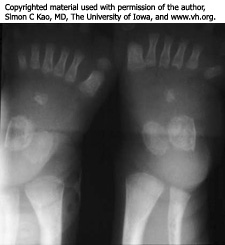Archival Notice
This is an archive page that is no longer being updated. It may contain outdated information and links may no longer function as originally intended.
Home | Glossary | Resources | Help | Contact Us | Course Map
Inbreeding is the mating of related individuals and can alter gene frequency in a population. When related individuals mate, the child can inherit identical copies of the gene through both parental lineages, resulting in an increase in homozygosity at any given locus.04
The degree of a relationship between two persons can be measured using the inbreeding coefficient, F. With inbreeding, the expected heterozygosity is reduced by a fraction, F, and that of homozygotes are increased (NRC, National Research Council).
Inbreeding Coefficient | |
|---|---|
| Relationship | F |
| Parent/child | 1 /4 |
| Siblings | 1 /4 |
| First cousins | 1 /16 |
Population genetics studies show some substructure within racial groups. Mating tends to occur between persons who are likely to share some common ancestry. Allele frequencies have not yet been homogenized because people tend to mate within these subgroups (NRC). If there is subdivision within a population, it will lead to decreased heterozygosity within that subgroup. Population substructure may exist, and can be adjusted for with the use of a correction factor, theta (θ). (NRC). This will be covered in more detail in course: Population Genetics & Statistics.
Read about Population Subgroups in NRC.
Read about Subpopulation Theory in NRC.
Inbreeding can allow recessive alleles to become homozygous; therefore, unusual recessive diseases are much more common among the children. Inbred populations deviate from expected Hardy-Weinberg frequencies and there is a greater chance that certain alleles can become fixed within the population. When an allele becomes fixed in a population, all individuals are homozygous at this locus because no other alleles exist.
Watch a video on inbreeding presented by Greggory LaBerge.
See the YouTube Terms of Service and Google Privacy Policy
The Amish population of Lancaster County, Pennsylvania, is an example of an inbreeding group of individuals. As a result, the Amish suffer from a variety of genetic disorders including Ellis - van Creveld (EVC) syndrome, a disease caused by inheritance of two mutated copies of the EVC gene. Symptoms of the disease include short-limbed dwarfism with polydactyly (additional fingers or toes), bone malformations in the wrist, heart defects, and prenatal eruption of the teeth.14
Additional Online Courses
- What Every First Responding Officer Should Know About DNA Evidence
- Collecting DNA Evidence at Property Crime Scenes
- DNA – A Prosecutor’s Practice Notebook
- Crime Scene and DNA Basics
- Laboratory Safety Programs
- DNA Amplification
- Population Genetics and Statistics
- Non-STR DNA Markers: SNPs, Y-STRs, LCN and mtDNA
- Firearms Examiner Training
- Forensic DNA Education for Law Enforcement Decisionmakers
- What Every Investigator and Evidence Technician Should Know About DNA Evidence
- Principles of Forensic DNA for Officers of the Court
- Law 101: Legal Guide for the Forensic Expert
- Laboratory Orientation and Testing of Body Fluids and Tissues
- DNA Extraction and Quantitation
- STR Data Analysis and Interpretation
- Communication Skills, Report Writing, and Courtroom Testimony
- Español for Law Enforcement
- Amplified DNA Product Separation for Forensic Analysts


